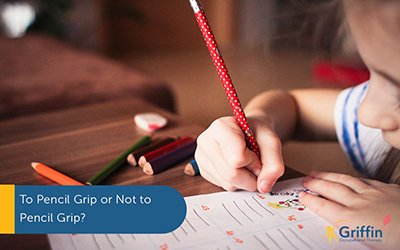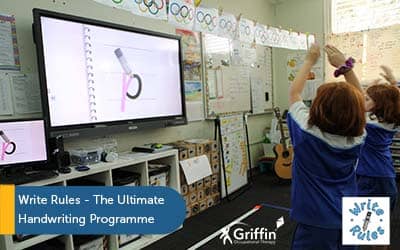There’s more to handwriting than meets the eye
Handwriting is an incredibly complex skill. Before children can hold a pencil, they need to be able to sit up and move their arm independently of their body. They need to be able to isolate their fingers to hold their pencil. To write, they first need to visually understand the difference between letters. And, then they need to remember how to form the letters. Before this they also need to have success with pre-writing shapes. In this post, we will explore the motor skills which are essential for handwriting success.

There’s more to handwriting than meets the eye
Handwriting is an incredibly complex skill. Before children can hold a pencil, they need to be able to sit up and move their arm independently of their body. They need to be able to isolate their fingers to hold their pencil. To write, they first need to visually understand the difference between letters. And, then they need to remember how to form the letters. Before this they also need to have success with pre-writing shapes. In this post, we will explore the motor skills which are essential for handwriting success.
Gross and fine motor skills form the foundation
Well developed fine and gross motor skills are an essential component of a child’s readiness to write. These skills develop sequentially. Children learn to roll before they sit. They sit before they crawl. Then, typically, children crawl before they walk or run. These large motor movements form the foundation stability required to hold their pencil later on. Next, the children develop dexterity and hand control. They learn to drop, or release, objects. They learn to play with Duplo, bricks and beads. All of these activities help children to develop the hand skills required to hold their pencil. We explore these steps further in our article on pencil grasp development. In this article, we explore some of the motor skills required for handwriting readiness and how you can help a child to develop them.
Essentials 1 – Gross motor skills
Motor skills for handwriting – Postural control and shoulder stability
Before a child can hold their pencil effectively, they need to be able to sit up. Sitting requires adequate postural control. Postural control is our ability to keep our bodies stable when we are stationary and when we move. It is essential for us to be able to use our arms, hands and fingers with good control.
Imagine a building. In order for it to stand up, there needs to be strong foundations underneath. Without strong foundations a building would fall over. Our foundation is postural control. Postural control starts developing from the moment a child is born. Initially, babies have no postural control. Even their heads need to be held and supported. Over time a baby can hold their head up and then push up on their arms and roll over. Tummy time helps to develop these skills and helps with shoulder stability.
Our shoulders are the next layer of the foundation. They are like the concrete floor on a building. Our shoulders support our arms and hands, in the same way the floor supports the walls. When there is reduced shoulder stability, a child will have less control over their arms and hand.
Help a child to develop their postural control and shoulder stability
- Get off the devices and out into the playground!
- Climbing is a great way to help to improve shoulder stability.
- Swings and slides help with postural control.
- Walking, or running, up and down unstable surfaces also helps with postural control and endurance.
- Crawling is also a great way to help with shoulder stability. Tunnels can be fun but if you don’t have these, sleeping bags and duvet covers make good substitutes. Chairs and tables can also be used to make obstacle courses.
- For older children, cycling and gymnastics or martial arts are great. Martial arts and gymnastics have the added bonus of including movements using the left and right sides and both sides together.
- Free movement songs (e.g. Go Noodle) and yoga (e.g. Cosmic Kids) are also available on YouTube.
- Kim also created Move with Lucy to help children with their motor control.

Handwriting starts with tummy time
All of the movements a child makes in their first, second and third years of life support their motor skill development. Tummy time helps to strengthen the neck muscles. It gives feedback to the hands when children press up. This helps to improve postural control and body awareness. These early movements, including crawling, help a child to be ready to hold a pencil when it’s time.
Essentials 2 – Fine motor skills for handwriting
Finger and hand control
In order to hold their pencil with their fingers children first need to be able to isolate their fingers from their palm. Initially, when they hold a pencil, a child will grasp their entire hand around it. This is because they have not developed the hand control to isolate their fingers from their palm. As they have more experience with fine motor activities, children establish more control over their fingers. This is what allows them to hold their pencil with their fingers and eventually develop a dynamic pencil grasp. You can read more about pencil grasp development in this article – What does a good pencil grasp look like?
Help a child to develop their finger and hand control
- Messy play is a great way to help with hand awareness. Sand, shave foam and finger paint are a good starting point. Mud kitchen can be loads of fun. Cooking can also be fun. Making pizzas or cutting out pastry or biscuits are great ways to develop finger and hand control.
- Playdough and Dough Disco are excellent choices.
- Finger songs are also a great way to improve the fine motor skills of younger children. There are a number of animated songs on YouTube, this playlist has a good selection.
- The song ‘Crocodile Snap,’ is also written to help children to find their ‘crocodile fingers,’ or the fingers they need to use on their pencil.
- Construction toys, such as Duplo, Sticklebrix and Popoids, are great activities to help with finger and hand control.
- Musical instruments are brilliant as they help with hand control and timing and sequencing.
- Scissors and craft are also great choices.
- Many pretend play toys, e.g. doctor sets, dolls houses, trucks and cars, also encourage fine motor skills.
Sometimes children with fine motor skill delays will avoid these activities. This means they are not developing the required fine motor skills for handwriting success. It can be helpful to prompt these children to engage with them, to ensure they are getting the experiences, especially at nursery and in early years classrooms.
For children who need a bit more help with their pencil grasp development you could also consider the Kim’s handwriting programme – Write Rules. The programme includes activities and worksheets to help with development of pencil grasp and to support handwriting development. If you’re considering using a pencil grip, we would recommend reading our article To pencil grip, or not to pencil grip? to help you with your choice. The article also considers alternatives to pencil grips for younger children.
Dough Dance Video
Crocodile Snap

Fine motor skills are important
Fine motor play is just as important to prepare a child to hold a pencil as larger, or gross, movements. Typically, children are naturally inquisitive and will pull, push, roll, stack and poke everything in their grasp. Some children need extra encouragement and support to do this. In nursery and early years, it is helpful to ensure they are accessing the fine motor activities at least once a day to help with skill development.
Essentials 3 – Pre-writing skills
Handwriting is a complex activity. Pre-writing skills are the things a child needs to be able to do before they are ready to write. This includes being able to colour and trace inside lines, and to draw certain shapes. Shapes such as vertical and horizontal lines and circles form the foundation of most letters. Think of the letter ‘a’ for example. It starts off as a circle, and then has a vertical line on the side. Additionally, a child needs to be able to draw their oblique lines for letters such a ‘k,’ ‘v,’ ‘w,’ and x.’
A useful way to think about pre-writing skills is to call it ‘mark making’. So, before a child writes they need to be able to use their pencil to make marks and colour. It can be really helpful let the child be as creative at they want to. There are no rules. Chalk and black boards are an excellent choice! You just want the child to be holding onto a marker, chalk, crayon or pencil and make some marks. This helps with their pencil control.
Helping a child with their pre-writing skills
- Colouring and drawing are really important foundations for handwriting. These skills help with the pencil control required for handwriting.
- If a child isn’t that interested in colouring, find colouring sheets of their favourite characters. Use different types of markers and crayons.
- Bath crayons can also be fun, as can window markers to write on windows and mirrors, and drawing with chalk on the pavement.
- Activity workbooks with mazes and dot to dots are also good at this stage.
- If you’re really struggling to engage a child with a pen and paper you could also try a stylus with a tablet. Just make sure they are using the stylus and not their finger so they are practising holding onto a ‘pen.’
- The ‘aqua-doodle‘ water based drawing sheets can be fun.
- Practise pre-writing shapes as these are the foundation shapes for handwriting. They include vertical and horizontal lines, circles, squares and oblique lines (\ /) and crosses (+ x). Unfortunately, the current UK curriculum requires children to write in reception, which in the case of four year olds, is before they are developmentally ready. It is important for children to practice pre-writing skills first.
Kim explores pre-writing shapes further here in this article – Pre-writing shapes – what are they and how to teach them?
Pre-writing skills are often forgotten. Children are just expected to move from colouring to writing. Pre-writing skills lay the foundation for a child’s directional control and awareness. They help a child to be ready for form letters.
Essentials 4 – Visual Perception
Visual perception is the making sense of what we see. It’s much more than having 20/20 vision. It relates to how the brain interprets the information that our eyes see. Before a child can write a letter, they need to be able identify it. They need to remember what it looks like. This then lets them write it. If you don’t know what the letter ‘a’ looks like, you can’t write it. This is why reading is really important as it helps children to start to identify the letters, well before they start to write them. It’s much easier to identify a letter and name it than it is to remember and write it. This is also why copying is easier than writing from memory.
Helping a child with visual perception skills
- Reading
- Puzzles
- Matching games
- Identifying shapes and letter in the environment (e.g. i-spy)
Essentials 5 – Language
Whilst this may seem like a sideways step, language is also a critical component of handwriting. Like visual perception, if you can’t imagine it, or say it, you’re really going to struggle to write it.
A few ideas to help with language skills
- Talk talk talk!
- Reading out aloud.
- Nursery rhymes and songs
- Tell stories
- Observe and comment
You can find more ideas to help to support language development for children ages 0-8 in this article.
In summary
Handwriting is an important skill for success throughout schooling. It is, however, a very complex skill. In this article I have explored five essential components for handwriting and why motor skills are essential to support pencil grasp and handwriting. I’ve also included some tips on how you can support children to develop their skills. If you need more ideas to support fine motor skill development – check our our fine motor and handwriting programme.



